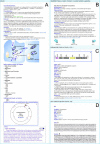VFDB: a reference database for bacterial virulence factors
- PMID: 15608208
- PMCID: PMC539962
- DOI: 10.1093/nar/gki008
VFDB: a reference database for bacterial virulence factors
Abstract
Bacterial pathogens continue to impose a major threat to public health worldwide in the 21st century. Intensified studies on bacterial pathogenesis have greatly expanded our knowledge about the mechanisms of the disease processes at the molecular level over the last decades. To facilitate future research, it becomes necessary to form a database collectively presenting the virulence factors (VFs) of various medical significant bacterial pathogens. The aim of virulence factor database (VFDB) (http://www.mgc.ac.cn/VFs/) is to provide such a source for scientists to rapidly access to current knowledge about VFs from various bacterial pathogens. VFDB is comprehensive and user-friendly. One can search VFDB by browsing each genus or by typing keywords. Furthermore, a BLAST search tool against all known VF-related genes is also available. VFDB provides a unified gateway to store, search, retrieve and update information about VFs from various bacterial pathogens.
Figures

References
-
- Waldvogel F.A. (2004) Infectious diseases in the 21st century: old challenges and new opportunities. Int. J. Infect. Dis., 8, 5–12. - PubMed
-
- Byarugaba D.K. (2004) Antimicrobial resistance in developing countries and responsible risk factors. Int. J. Antimicrob. Agents, 24, 105–110. - PubMed
-
- Hogan D. and Kolter,R. (2002) Why are bacteria refractory to antimicrobials? Curr. Opin. Microbiol., 5, 472–477. - PubMed
Publication types
MeSH terms
Substances
LinkOut - more resources
Full Text Sources
Other Literature Sources
Research Materials

